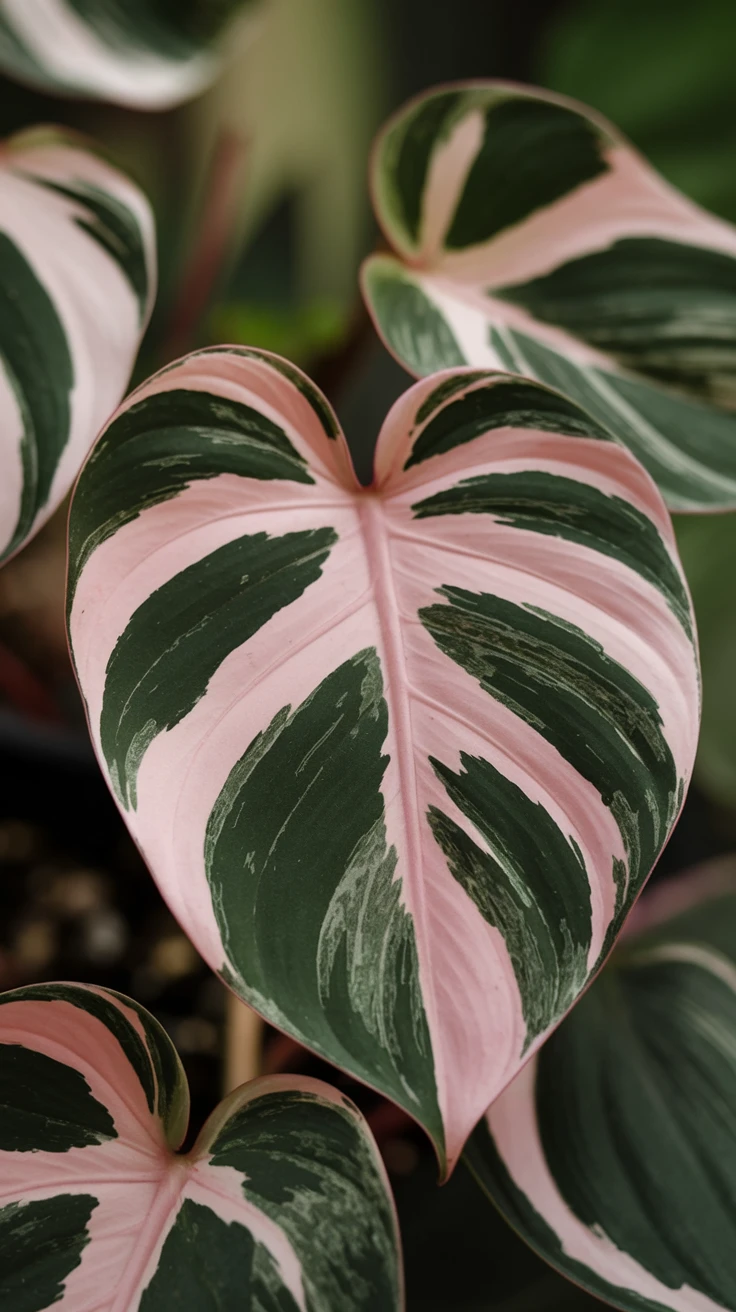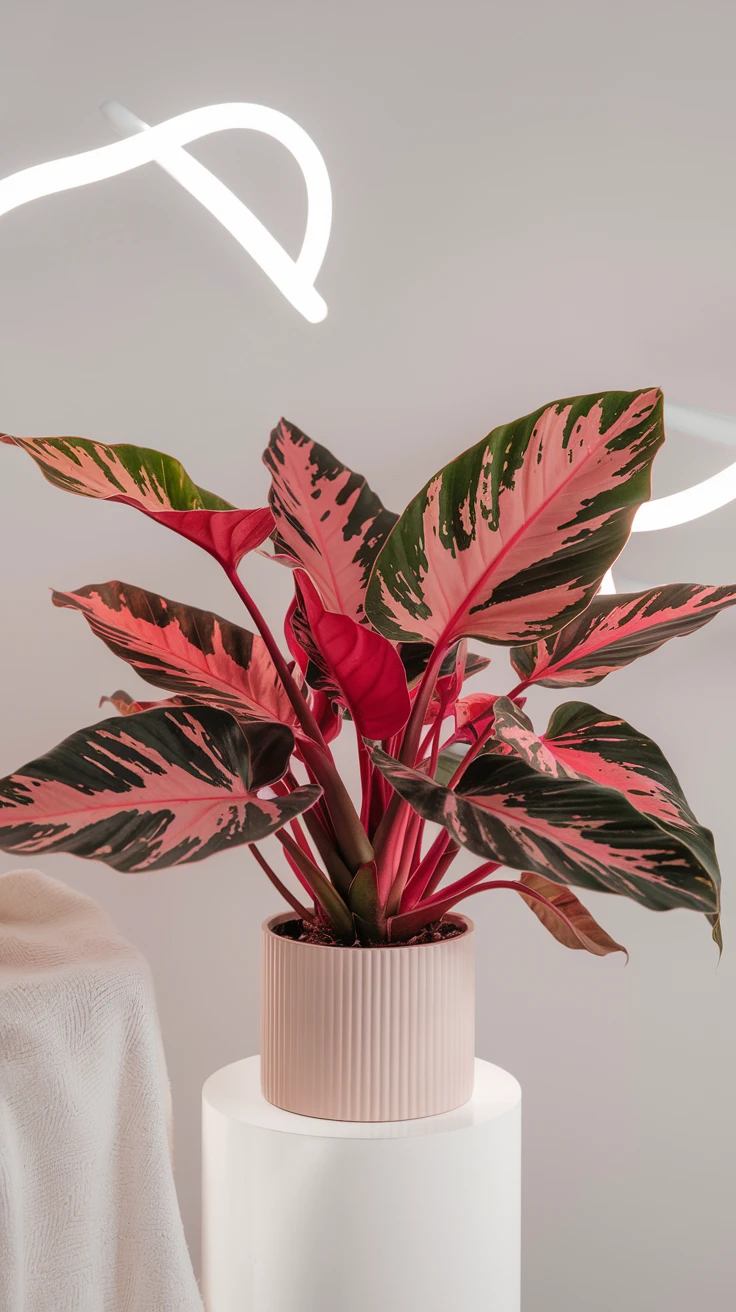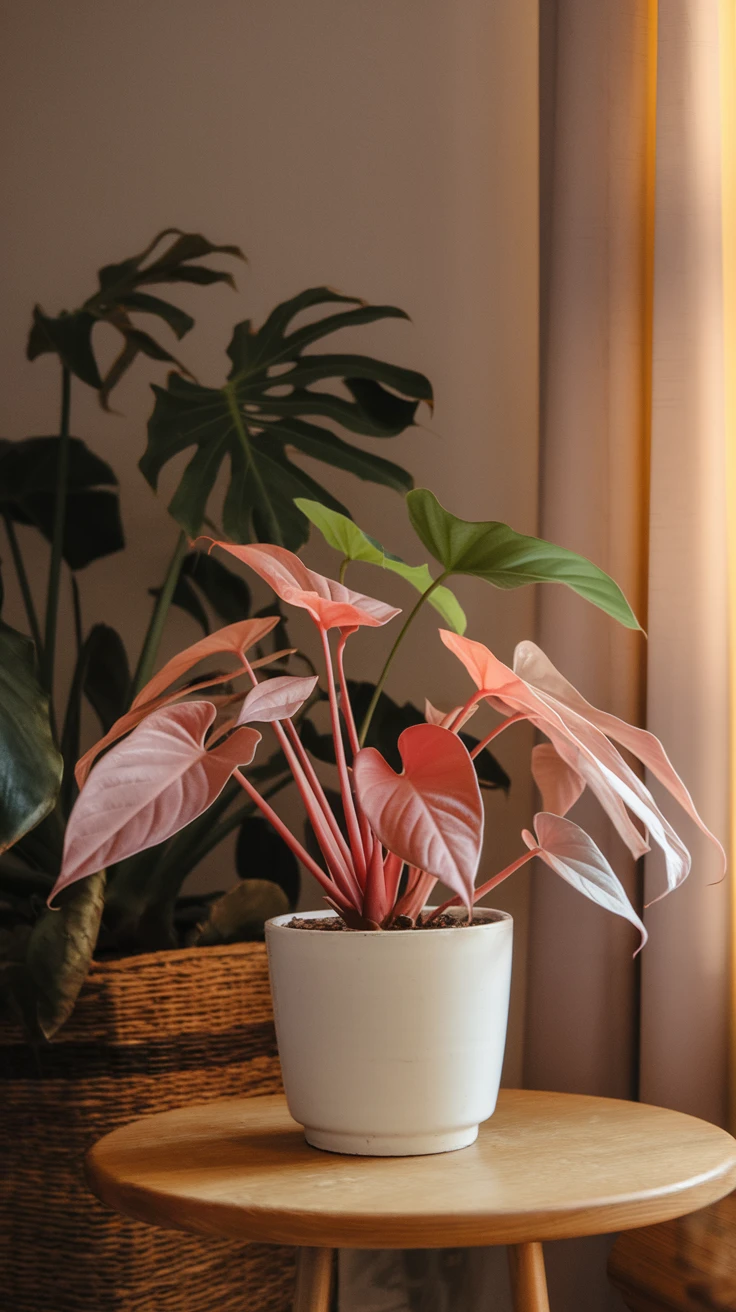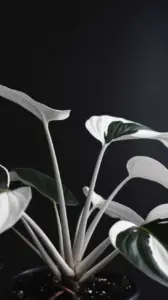Biological Features of Philodendron Pink Princess
The Philodendron Pink Princess is a stunning cultivar known for its unique variegation. This plant displays vibrant pink and green leaves, making it a popular choice for indoor gardens. The variegation occurs due to a mutation in the plant’s chlorophyll, leading to stunning color contrasts. As a tropical plant, it thrives in warm and humid conditions, making it ideal for homes that mimic its native environment.

Its leaves can grow large, reaching lengths of up to 12 inches. Each leaf presents a heart shape, which is characteristic of many Philodendron species. The pink hues can vary significantly based on light exposure. In brighter conditions, the pink color often appears more pronounced.
Additionally, the Philodendron Pink Princess prefers well-draining soil to prevent root rot. Regular watering is crucial, ensuring the soil remains moist but not soggy. When grown outdoors, it can also produce aerial roots, which help the plant climb for additional support.
Key Biological Features
| Feature | Description |
|---|---|
| Scientific Name | Philodendron erubescens |
| Leaf Size | Up to 12 inches long |
| Leaf Shape | Heart-shaped |
| Color Variance | Pink and green |
| Soil Preference | Well-draining, rich in organic matter |
| Watering Needs | Moist soil, avoid waterlogged conditions |
These biological features make Philodendron Pink Princess an intriguing addition to any plant collection.
History and Cultural Significance
The Philodendron Pink Princess is more than just a beautiful plant. It has intriguing historical and cultural roots. Discovered in the tropical rainforests of South America, its vibrant pink and green variegated leaves capture the attention of many plant enthusiasts.
This plant symbolizes allure and beauty. Historically, it has been associated with love and affection in various cultures. Many people believe it brings good luck and prosperity. Its striking appearance makes it a favorite among interior decorators.
Interesting Facts
- The Pink Princess was first identified in the 1970s.
- This plant quickly gained popularity in the house plant community.
- Collectors often search for this rare variant due to its unique coloration.
- The leaves can vary significantly, which adds to its appeal.
In the realm of indoor gardening, the Philodendron Pink Princess has carved out a significant niche. Many people appreciate its low maintenance needs, making it accessible for both novice and experienced gardeners.
Furthermore, the cultural significance of this plant grows. In many households, it symbolizes personal growth and strength. People often gift or display the Pink Princess at significant events, reinforcing its connection to positivity.
As you nurture a Philodendron Pink Princess, you embrace its rich history. Each leaf tells a story of journey and elegance, adding charm to your home.

Ideal Growing Conditions for Philodendron Pink Princess
The Philodendron Pink Princess thrives when placed in the right growing conditions. It enjoys bright, indirect sunlight, which helps maintain its vibrant pink variegation. Avoid direct sunlight, as it can scorch the leaves, leading to unattractive brown spots.
Light Requirements
This plant prefers a location that offers filtered light. If grown indoors, place it near a window that allows light to diffuse to prevent leaf burns. Thus, east or north-facing windows work well.
Temperature and Humidity
Philodendron Pink Princess grows best in temperatures ranging from 65°F to 80°F (18°C to 27°C). Sudden temperature changes can stress the plant. To promote lush growth, maintain humidity levels between 50-70%. If your home is dry, consider using a humidity tray or misting occasionally.
Soil Type
Using well-draining soil is crucial for the health of the plant. A mix that retains moisture yet drains excess water is ideal. Incorporating ingredients like perlite or orchid bark can enhance drainage.
Watering Needs
Water the Philodendron Pink Princess when the top inch of soil feels dry. Overwatering can lead to root rot, which is detrimental. Conversely, underwatering can cause leaves to droop. Generally, watering once a week is sufficient, but adjust based on environmental conditions.
| Condition | Ideal Range |
|---|---|
| Light | Bright, indirect light |
| Temperature | 65°F to 80°F (18°C to 27°C) |
| Humidity | 50-70% |
| Soil | Well-draining mix |
| Watering | Weekly, or as needed |
By providing these ideal conditions, your Philodendron Pink Princess will flourish, showcasing its stunning foliage. Remember, consistent care is key to success!

Plant Care and Maintenance
The Philodendron Pink Princess is a stunning houseplant that requires specific care to thrive. First, ensure you provide the right light conditions. This plant loves bright, indirect sunlight. However, it can also tolerate lower light levels, although growth may slow down. Next, consider watering practices. Keep the soil consistently moist, but avoid overwatering—this can lead to root rot. Allow the top inch of soil to dry before watering again.
Humidity plays a significant role in the health of your Philodendron Pink Princess. This plant thrives in a humid environment. Therefore, misting the leaves or using a humidifier can help. In terms of temperature, maintain a range between 65°F to 80°F. Sudden temperature drops can stress the plant, so be cautious of drafts and heating vents.
Fertilization is necessary for a healthy Philodendron. During the growing season, use a balanced houseplant fertilizer every 4-6 weeks. This encourages robust growth and vibrant leaf coloration. In fall and winter, reduce feeding to once a month or stop altogether, as the plant enters dormancy.
Pests and Issues on Philodendron Pink Princess
Regularly check for pests such as spider mites and mealybugs. If spotted, treat your plant promptly. You can wash the leaves with a gentle soap solution or use insecticidal soap. Furthermore, ensure proper air circulation around your plant to minimize disease and pests.
- Provide bright, indirect light for optimal growth.
- Keep soil consistently moist, but avoid sogginess.
- Maintain high humidity levels for healthy foliage.
- Fertilize monthly during the growing season with a balanced fertilizer.
- Monitor for pests and treat them immediately.
- Avoid sudden temperature changes to keep the plant stable.
With attentive care, the Philodendron Pink Princess can flourish and become a highlight of your indoor plant collection. Remember that each plant is unique and may have slightly different needs. Therefore, observing your plant will help you cater to its specific requirements effectively.

Propagation Techniques for Philodendron Pink Princess
Propagation techniques for the Philodendron Pink Princess can be both rewarding and enjoyable. This vibrant plant boasts stunning pink variegation. To propagate your Philodendron Pink Princess successfully, consider using several effective methods.
Stem Cuttings
The most common propagation method is through stem cuttings. Start by selecting a healthy stem with at least one node. Using a clean, sharp pair of scissors, cut at a 45-degree angle. Place the cuttings in water or directly in a potting mix. If you choose to root them in water, ensure the node is submerged. Change the water regularly to prevent algae build-up.
Soil Propagation
When propagating directly in soil, prepare a well-draining potting mix. Make a small hole in the mix. Then, insert the cutting, ensuring that the node is buried. Water the mix gently. Keep the soil moist but not soggy. A humidity dome can help maintain moisture levels, promoting healthy root growth.
Air Layering
Air layering is a more advanced technique for propagation. To perform air layering, select a healthy stem. Make an upward cut about one-third through the stem. Apply rooting hormone to the cut area. Wrap the cut with moist sphagnum moss and cover it with plastic wrap. This will help retain humidity. Once roots develop, cut below the rooted area and transplant it into a pot.
Whichever propagation technique you choose, ensure your Philodendron Pink Princess receives bright, indirect light while rooting. It’s crucial to monitor moisture levels consistently. Be patient; roots typically take a few weeks to develop. With proper care and techniques, you can expand your collection of this beautiful plant.
Common Problems and Solutions
The Philodendron Pink Princess is a stunning plant but can face several common issues. Recognizing these problems early is key to maintaining its health. Below are some frequent problems with their corresponding solutions.
1. Yellowing Leaves
Yellowing leaves often indicate overwatering or underexposure to light. To rectify this:
- Check the soil moisture; only water when the top inch is dry.
- Ensure the plant receives bright indirect light.
2. Brown Leaf Tips
If you notice brown tips on the leaves, this generally indicates low humidity or lack of water. To fix this issue:
- Increase humidity levels around the plant by misting or using a humidifier.
- Make sure to water the plant properly and avoid letting it dry out completely.
3. Pests Infestation
Pests, such as spider mites or aphids, can be a common issue for the Philodendron Pink Princess. They may cause damage to the leaves. Here’s how to manage pests:
- Regularly inspect your plant for any signs of pests.
- Use insecticidal soap or neem oil for treatment if you detect an infestation.
4. Leaf Drop
Leaf drop can occur due to stress from temperature fluctuations, lack of water, or overcrowding. To combat leaf drop:
- Keep the plant in a stable environment, avoiding extreme temperature changes.
- Check for root binding and repot if necessary.
5. Poor Growth
If your Philodendron Pink Princess isn’t growing well, consider these factors:
- Ensure your plant receives enough light.
- Fertilize every four to six weeks during the growing season with a balanced fertilizer.
| Problem | Symptoms | Solutions |
|---|---|---|
| Yellowing Leaves | Leaves turn yellow, wilting | Water less, provide indirect light |
| Brown Leaf Tips | Leaf tips turn brown | Increase humidity and water regularly |
| Pests Infestation | Visible pests on leaves | Treat with insecticidal soap |
| Leaf Drop | Leaves fall prematurely | Maintain stable environment |
| Poor Growth | Stunted growth | More light and regular fertilizing |
By understanding these common problems and implementing the solutions, you can enjoy a thriving Philodendron Pink Princess in your home.
Seasonal Care Adjustments
Philodendron Pink Princess requires specific care adjustments throughout the seasons. These adjustments help maintain its health and vibrancy. Additionally, understanding its seasonal needs enhances growth.
Spring Care
During spring, increase watering as the plant enters its growth phase. You should monitor soil moisture closely.
- Fertilize every 4-6 weeks.
- Provide bright, indirect light.
- Check for pests regularly.
Summer Care
In summer, humidity levels rise. Ensure adequate moisture to prevent leaf browning. Summer is also the time to boost light exposure.
- Water more frequently.
- Keep temperatures above 65°F (18°C).
- Increase humidity if indoors.
Autumn Care
As autumn approaches, gradually reduce watering. The plant may slow down growth and needs less fertilizer.
- Water only when the topsoil is dry.
- Maintain moderate light levels.
Winter Care
During winter months, Philodendron Pink Princess may become dormant. Limit water and fertilization further.
- Water less frequently, every 2-3 weeks.
- Keep in a well-lit area.
- Protect from cold drafts.
Microclimate Setup Tips
Creating the ideal microclimate for your Philodendron Pink Princess is essential for its growth and health. This plant thrives in specific environmental conditions. Thus, pay attention to the following tips to ensure a nurturing environment.
- Light Requirements: Philodendron Pink Princess prefers bright, indirect light. Avoid direct sunlight, as it can scorch the leaves.
- Humidity Levels: Aim for humidity around 50-60%. You can increase humidity using a humidifier, misting, or placing it on a pebble tray filled with water.
- Temperature: This plant is happiest in temperatures ranging from 65°F to 80°F (18°C to 27°C). Make sure to avoid cold drafts.
- Watering: Water the plant when the top inch of soil feels dry. Overwatering can lead to root rot, while underwatering can cause wilting.
- Soil Type: Use a well-draining potting mix. A blend of peat moss, perlite, and pine bark works well for drainage and aeration.
- Fertilization: Fertilize every month during the growing season. Use a balanced liquid fertilizer diluted to half strength.
By following these microclimate setup tips, you can create an environment that allows your Philodendron Pink Princess to flourish. Remember, consistent care leads to vibrant, healthy plants.
Frequently Asked Questions
The Philodendron Pink Princess is a popular houseplant known for its stunning pink-variegated leaves. Many people have questions about how to care for this unique plant. Below are some common queries and answers regarding its maintenance and growth.
How often should I water my Philodendron Pink Princess?
It’s essential to allow the top inch of the soil to dry out before watering. Typically, watering every 1-2 weeks is ideal. However, this frequency may vary based on humidity and temperature. During the summer, you may need to water more frequently than in the winter.
What type of light does it need?
The Philodendron Pink Princess thrives in bright, indirect sunlight. Too much direct sunlight can scorch its leaves, while too little can hinder its growth and variegation. Ideally, place it near a window with filtered light.
Is it toxic to pets?
Yes, the Philodendron Pink Princess is toxic to cats and dogs if ingested. Symptoms of poisoning include vomiting and difficulty swallowing. Keep it out of reach of pets for their safety.
How can I encourage more variegation?
To promote variegation, ensure your plant receives adequate bright light. Variegation can diminish in low-light conditions. Additionally, consider fertilizing with a balanced fertilizer during the growing season.
Summary and Recommendations
The Philodendron Pink Princess is a stunning plant known for its striking pink variegation. With its unique coloration, it brings a vibrant touch to any space. This plant thrives in bright, indirect sunlight, making it ideal for indoor spaces. Ensure the soil is well-draining, as this helps prevent root rot and promotes healthy growth.
Regular watering is essential, but avoid overwatering. The soil should dry out slightly between watering sessions. Furthermore, humidity levels should be maintained, as the Philodendron Pink Princess enjoys a humid environment. This can be achieved by misting or placing a humidifier nearby.
In terms of fertilization, it benefits from a balanced, water-soluble fertilizer during the growing season. This promotes vigorous growth and enhances the beautiful pink foliage. However, during the winter months, reduce feeding since the plant’s growth slows down.
Finally, regular pruning helps maintain its shape and encourages fuller growth. Overall, the Philodendron Pink Princess is an excellent choice for plant enthusiasts seeking both beauty and ease of care.






